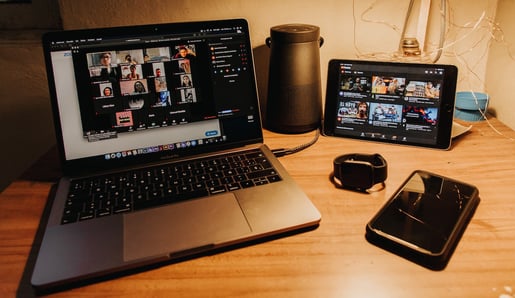
While professionals can be students, students are not always professionals. Therefore, their learning process often looks a little different. Next up on our blog series, "Education and Technology - Relationship Status," we're looking at the role technology is playing in educating our professionals. Our previous blog examined the impact technology is having on student learning.
According to Entrepreneur magazine, the 4 best ways to effectively train employees includes:- Blend in person training with online training.
- Provide hands-on training.
- Incorporate mobile apps.
- Let employees learn at their own pace.
Questions to think about:
- What role does technology play in professional learning?
- How has it changed things for companies across the globe?
- What is the downside to using various technologies to facilitate professional learning?
After researching the latest technologies companies are using to facilitate learning, we have compiled a list of our Top 8 Tech Tools for Professional Learning, Development, & Employee Training. Which ones do you use?
- Video conferencing: GoToMeeting and Zoom
- Intelligent 360 All-in-one Video Conferencing Hardware: Owl Labs
- LMS/Online course content creation and delivery: Coassemble
- LMS that integrates with SalesForce designed for professional training/education: Whatfix
- Leading Team Learning Software: Lessonly
- Motivation Assessment for employees: Cravety
- Social Network: LinkedIn
- Simulation training tool: Simulation Technology
Perhaps the most common way to train new employees or educate professionals is through video conferencing of some kind. Meeting virtually does, however, has its pros and cons. In addition, we use the technology a great deal internally to facilitate professional learning because we have offices in two states, Alabama and Michigan.

Below is our list of pros and cons when using video conferencing for professional learning based on firsthand experience. What would you add to the list?
PROS
- Time saver: With travel onsite unnecessary, professionals spend less time on the road and more time learning. This is probably the #1 benefit from using video conferencing for professional learning.
- Money saver: With no travel involved, the cost of hotels, flights, rentals, mileage, and meals are huge savings. Time is money and opportunity costs are something that must be considered when training & educating your team. This is a huge pro to virtual meetings.
- Reach larger audience: Without room size limits and logistics concerns, many more people can be trained at one time. Not to mention access in the country and out. This also contributes to more diversity since companies can include personnel that may be from other countries.
- Avoid too much water cooler chat: Face-to-face time is a good way to get to know other people. Seeing their body language and personal style helps us learn about our colleagues. However, this "getting to know each other" time can also turn into telling personal stories and wasting time around the water cooler talking about last night's episode of "Survivor." While it may be ok during normal business hours from time to time, when working with a tight agenda and training objectives, it could really blow your schedule.
CONS:
- Lack of engagement: Not having a face-to-face component can lend itself to multi-tasking which could decrease engagement. I know our team has been guilty of this from time to time.
- Lack of personal commitment: Research shows that people do view a virtual commitment slightly different than a face to face meeting. They are more likely to cancel or be a no-show for a virtual meeting or phone call than an onsite scheduled meeting.
- Difficult feedback, Q&A, and interaction: While technology is improving, it can still be confusing in virtual meetings/trainings about whose turn it is to talk.
- Technology fails sometimes: Recently, we had a big internal kick-off marketing meeting to learn our new messaging and market position. The presentation was well planned out and included videos from leadership and a slideshow. Unfortunately, the technology did not cooperate and instead of being an exciting kick-off, it turned into a technology FAIL! Having too many screens, media sources, and locations served to be a challenge too big to overcome. It's important to ALWAYS have a plan B when relying solely on technology to come through. Hey, if you were planning an outside wedding, you'd likely have a plan B in case it rained!
Whether your company is hiring new employees or educating current employees about new products and processes. Be sure and take full advantage of all the technology that can make that job easier, less expensive, and much more efficient.
This blog series closes with our last blog, "Generation Gap Between Education and Technology for Baby Boomers, Millennials, and Gen. Alpha." This blog gives a glimpse into how we apply what we've learned from technology as we we take a close look at different generations.


.jpg)


